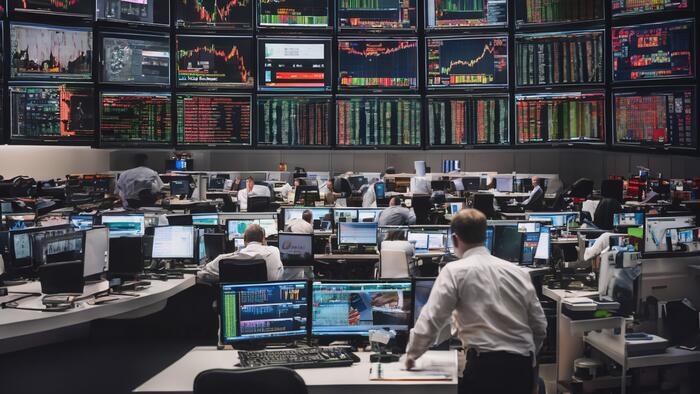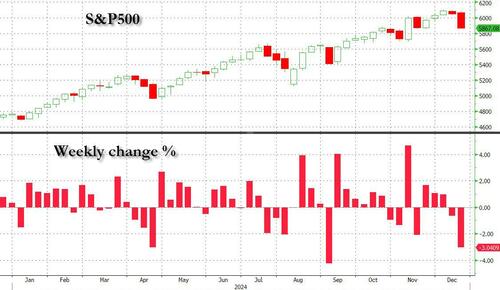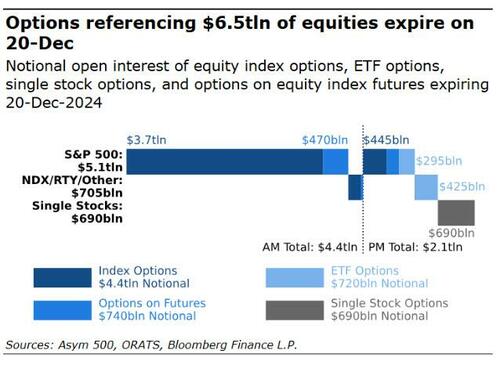


US equity futures and global markets are broadly risk-off to end a turbulent week after the US House rejected a temporary funding plan backed by Donald Trump (38 republicans voted against the bill) which would have avoided a gov’t shutdown that otherwise will start a midnight, with trade war concerns mounting (Trump said “I told the European Union that they must make up their tremendous deficit with the US by the large scale purchase of our oil and gas. Otherwise it is tariffs all the way!!!”). Expect elevated volumes today due to the last option expirty/quarterly rebalance of the year. As of 8:00am ET, S&P futures are down 0.8%, Nasdaq futs tumble 1.4%, with technology stalwarts such as Tesla and Nvidia sliding in early trading as momentum reversed with a bang. Europe’s Stoxx 600 weakened 1.7% as Novo Nordisk A/S fell by the most on record on the back of disappointing data from a treatment trial; the rest of the world not much better: FTSE -95bps, DAX -1.3%, CAC -1.05%, Nikkei-29bps, Hang Seng -16bps, Shanghai -6bps. 10Y treasury yields dipped a little after surging in the past three days, down 2bps to 4.54%, with the Bloomberg US dollar index also easing back a bit as both the yen and euro gain. Bitcoin tumbled amid the riskoff mood, sliding as much as 8% to a low of $92K and dragging down MicroStrategy Inc. and other crypto-related companies in premarket trading. Oil reversed earlier losses with gold also rising on expectations of aggressive Chinese stimulus. Today's economic calendar will see the November core PCE, personal income and spending as well as the latest UMich data.
In premarket trading, FedEx rose 6% after the company said it plans to spin off its freight division into a separate publicly traded company in a deal that will streamline the parcel giant. Eli Lilly jumped 5% after competitor Novo Nordisk A/S gave data from a highly anticipated trial of its experimental weight loss drug, CagriSema, that fell short of expectations. Nike meanwhile tumbled 7% as management expected revenue in the current quarter to decline in the low double digits, a steeper drop than the 7.7% decline posted last quarter. Here are the other notable premarket movers:
The S&P 500 was heading for its biggest weekly drop since at least September, with the index down 3% on the week after the Fed's political hawkish pivot sparked a global selloff.
Stock market volatility spiked in recent days as a hawkish pivot by the Federal Reserve made traders question whether this year’s tech-fueled rally could extend further in a higher rates environment, despite a resilient US economy. Friday’s personal consumption expenditures data for November, the Fed’s preferred measure of underlying inflation, will offer further clues on 2025’s rate path. For now, the swaps market is implying between one and two quarter-point reductions for next year, a decrease from a month ago when two cuts were fully priced.
Adding to the nerves is Friday’s US options expiration, which has historically stoked turbulence, and offers a final hurdle to end-of-year calm. The quarterly “triple-witching” will see a whopping $6.5 trillion worth of options tied to individual stocks, indexes and exchange-traded funds fall off the board, this year’s largest. The opex will also collapse the dealer gamma, unclenching the market, and allowing for much wider volatility in the coming (very illiquid) days.
The fact that CTAs are also sellers in all scenarios (according to Goldman) isn't helping the already downbeat mood.
1 Week:
1 Month:
Concerns are also growing about the implications of the Republican-led House rejecting a temporary funding plan backed by President-elect Donald Trump on Thursday, with a US government shutdown looming in less than 24 hours.
The development can “inevitably increase the market volatility in the short term, especially after Fed’s hawkish pivot two days ago,” Jasmine Duan, a senior investment strategist at RBC Wealth Management Asia, told Bloomberg TV. Investors face risks from “potentially more sticky inflation and also the debt issue in the US,” she said.
“There’s plenty of room for volatility to kick in and a selloff to take place,” said Neil Birrell, chief investment officer at Premier Miton Investors. “There’s going to be less liquidity as well. You’ll see a rapid pace of moves taking place as people adjust their portfolios for the year-end and that could affect all asset classes.”
European stocks also slumped with all sectors dropping; banks, miners and construction are the worst-performing sectors. Euro Stoxx 50 slumps 1.2% as Novo Nordisk A/S fell by the most on record on the back of disappointing data from a treatment trial. FTSE 100 outperforms peers, dropping 0.5%. Here are some of the biggest movers on Friday:
Asian stocks fell for a sixth day, heading for their longest losing streak in eight months, as traders continued to mull the prospect of a more hawkish Federal Reserve. The MSCI Asia Pacific Index dropped as much as 0.7%, with TSMC and Alibaba Group among the biggest contributors to its decline. Tech-heavy benchmarks in South Korea and Taiwan were among the region’s worst performers, declining more than 1% each. The after-effects of this week’s relatively hawkish Fed meeting continued to weigh on Asian stocks, with the regional benchmark less than 1% away from falling into a technical correction. Traders awaited US inflation data due later Friday for further clues on the central bank’s policy outlook.
In FX, a Bloomberg gauge for the dollar was on course for its best week in a month despite ticking down on Friday. AUD and SEK are the weakest performers in G-10 FX; JPY and CHF outperform. The yen erased losses after Japan’s key inflation gauge strengthened for the first time in three months and Finance Minister Katsunobu Kato warned Japan would take appropriate action if there are excessive moves in the yen. BRL leads gains in EMFX, rising 2.5% with Brazil’s congress inching closer to delivering a diluted spending plan. A key gauge of Asian shares dropped for a sixth day.
In rates, treasuries are richer across the curve with gains on the day led by the front- and belly, keeping 2s10s and 5s30s spread near Thursday’s session highs. Treasury yields richer by 4bp to 1bp across the curve with front-end led gains steepening 2s10s spread by 1.5bp on the day and 5s30s by 3.5bp; 10-year yields trade around 4.54%, richer by 2bp on the day with bunds lagging by 1.5bp in the sector and gilts slightly outperforming. Similar bull-steepening trends seen across core European rates over the early London session while S&P futures, European stocks trade lower in a risk-off backdrop. Treasury auctions resume Dec. 23 with $69b 2-year note sale, followed by $70b 5-year and $44b 7-year note sales Dec. 24 and Dec. 26
In commodities, WTI drifts 1% lower to trade near $68.68. Most base metals are in the green. Spot gold rises roughly $10 to trade near $2,604/oz. Bitcoin falls below $95,000.
Today's US economic calendar includes November personal income/spending, PCE price index (8:30am), December University of Michigan sentiment (10am) and Kansas City Fed services index (11am). The Fed speaker schedule includes Daly due to appear on Bloomberg TV (7:30am) and Williams on CNBC (8:30am)
Market Snapshot
Top Overnight News
A more detailed look at global markets courtesy of Newsquawk
APAC stocks eventually traded mixed following a mostly lower open after the lead from Wall Street as markets digest a slew of central bank decisions whilst still feeling the hangover from the Fed. ASX 200 was pressured by heavyweight financial, materials, and healthcare sectors, whilst Utilities and IT bucked the trend and posted mild gains. Nikkei 225 was briefly supported by the recent JPY weakness, although later faltered as JPY eventually strengthened following hotter-than-expected CPI and currency jawboning by Japanese officials. Hang Seng and Shanghai Comp both opened lower and trimmed losses to later trade, with Chinese markets unfazed as the PBoC maintained its LPRs.
Top Asian News
European bourses began the morning entirely in the red, and continued to proceed lower as the session progressed; as it stands, indices generally reside at worst levels. As it stands, all European sectors find themselves in the red; in-fitting with sentiment. Whilst still in the red, Real Estate fares the best vs peers. Banks are by far the clear underperformer, weighed on by Deutsche Bank, which expects a Q4 EUR 300mln hit due to its Polish subsidiary litigation. US equity futures are in negative territory and drifting lower as the session progresses, following the glum mood seen in European trade. Foxconn (2354 TT) to pause pursuit of Nissan (7201 JT) as Honda (7267 JT) deal talks unfold, via Bloomberg citing sources
Top European News
FX
USTs
Commodities
Geopolitics
US event calendar
DB's Jim Reid concludes the overnight wrap
Welcome to the last EMR of 2024. Happy holidays from Henry, Peter, Asim and myself. I say this every year but a huge thanks for reading and interacting with us this year. Thanks for voting in the II survey again where we found out last week we had another couple of 1st places in the global analyst awards. It really means a lot that you took the time to vote, so many thanks. I'll be off skiing as of Monday but before I go it’s become a tradition to list my favourite TV shows of the year which I'll do at the end. Regular readers know that if I'm not travelling I try to escape to an hour of TV a night with my wife in between edits of the EMR. I hope you've enjoyed some of these too.
Before unveiling the rather salacious number one entry on the list, we have the small matter of a nervy last full week of the year to comment on with a possible US government shutdown dominating proceedings. For those wanting a quiet run up to Xmas, the good news is that there hasn't been any real follow-through to the Fed-induced slump on Wednesday. The bad news is that an initial recovery in markets struggled to gain traction yesterday, with the S&P 500 (-0.09%) posting a joint record 14th consecutive day of decliners outnumbering advancers. The data stretches back 100 years so this is some stat. Futures on the S&P 500 are down another -0.36% this morning, so will we break the record today?
There was also scar tissue in bond markets, with 10yr (+4.8bps) and 30yr (+6.0bps) Treasury yields reaching their highest levels since May. The one area where there was a sense that the moves may have been overdone was at the front end, where the rate priced in by the December 2025 meeting was down -4.5bps on the day to 3.96%. For all the speculation about the Fed returning to hikes, it’s worth remembering they still cut rates this week and signalled more ahead, so the easing bias remains, even if it’s not as aggressive as it was. Indeed, investors are still pricing in 37bps of cuts next year, which isn’t too far off the Fed’s median dot at 50bps. So for DB to be correct that there are no cuts next year, we will need the Fed and the market to continue to change their minds.
But when it comes to the next 24 hours, the big question now is whether a US government shutdown is about to happen. The situation has moved quickly since Wednesday, when Elon Musk fiercely criticised the stopgap spending bill negotiated in Congress, with Trump and JD Vance then coming out against it later that day. Yesterday saw House Republicans put forward an alternative proposal that would fund the government through March and raise the debt limit for two years. The debt limit issue had been pushed by Trump who even said he’d be open to abolishing the debt limit altogether, saying he “would support that entirely”. However, the latest bill was voted down by 235 votes to 174 in the House last night, with 38 Republicans joining virtually all Democrats in voting against it. This leaves the Republican House leadership searching for a Plan C with less than 24 hours to go before the shutdown deadline. And as it stands, Polymarket are currently pricing in a 64% chance of a shutdown before year-end.
Whilst all that was happening, we did get some very positive US data yesterday, which helped to reassure investors about the near-term outlook and encouraged a huge curve steepening. That included the weekly initial jobless claims, which fell back to 220k in the week ending December 14 (vs. 230k expected). In addition, the Q3 GDP data was revised higher, coming in at an annualised pace of +3.1% (vs. +2.8% before) and with the PCE inflation for Q3 revised up from +2.1% to 2.2%. The stronger data encouraged a steepening in rates with the 2s10s curve moving up +8.8bps to 24.1bps, which is its steepest closing level since June 2022, back when the Fed began to hike by 75bps per meeting. That came amidst a continued move higher for long-end Treasury yields, as both 10yr yields (+4.8bps to 4.56%) and 30yr yields (+6.0bps to 4.74%) rose to their highest levels since May. This was again driven by real yields, with the 10yr real yield on course to post its largest weekly increase since October 2023 (+21.6bps so far this week). Higher real yields also helped the dollar index (+0.35%) advance for the 9th time in 10 sessions, and up to its highest level since November 2022.
A more bullish narrative initially helped to boost US equities, with the S&P trading more than 1% higher early in the session. But this optimism faded as the day went on and the index was -0.09% lower by the close, building on its -2.95% slump the previous day. The moves were fairly muted across the major indices. The Magnificent 7 (+0.25%) edged higher but the NASDAQ (-0.10%) declined and the small-cap Russell 2000 (-0.45%) fell back to its lowest level since the US election.
Since I asked on Wednesday for a new moniker for the Mag-7 which may include fast rising Broadcom, I've had a wave of suggestions emailed through. Some of them great, some of them funny. However its hard to beat the "BAATMAAN" moniker that's been quietly doing the rounds for several weeks now. I've no idea who first came up with it but well played to them. I'm not sure if our "The Innov-eightors" or "The Domin-eightors" will catch on.
Over in Europe, the main news yesterday came from the Bank of England, who struck a more dovish note than expected. The main decision wasn’t a surprise, keeping the policy rate at 4.75%. But the decision was only made by a 6-3 vote, with the minority preferring a 25bp cut. Moreover, the statement made clear that the path was still towards further easing, and that a “gradual approach to removing monetary policy restraint remained appropriate.” In turn, that meant yields on 10yr gilts were only up +2.0bps yesterday to 4.58%, which was a much smaller rise than for 10yr bunds (+5.8bps) and OATs (+6.9bps). And perhaps most fascinatingly, 30yr gilt yields (+5.1bps) reached their highest since 2002 at 5.11% and above where they were a couple of years back during the LDI crisis.
Elsewhere in Europe, markets were catching up to the Fed’s hawkish moves the previous day, which happened after the European close. That pushed the STOXX 600 to a sharp -1.51% loss, with similar moves for the DAX (-1.35%), the CAC 40 (-1.22%) and the FTSE MIB (-1.78%). There was a particular underperformance for Swedish assets after the Riksbank’s latest policy decision as well. They cut their policy rate by 25bps, in line with expectations. But they also signalled that easing was nearing its end, saying that if the outlook were unchanged, “the policy rate may be cut once again during the first half of 2025”, with the policy rate forecast showing no further cuts beyond that out to 2027. That backdrop saw the OMX Stockholm 30 Index fall -2.23%, which was the biggest decline for the major European indices, whilst Sweden’s 10yr government bond yield was up +10.6bps.
Overnight, there’s been a fairly mixed performance for the major equity indices. In South Korea, the KOSPI (-1.58%) has experienced sharp losses, along with Australia’s S&P/ASX 200 (-1.24%). However, Japanese equities have been broadly unchanged after the latest inflation data was mostly as expected. It showed headline CPI moving back up to +2.9% in November as expected, whilst core-core inflation was up to a 7-month high of +2.4%. So the Nikkei is holding steady this morning with a +0.03% gain. The main outperformer have been Chinese equities, with the CSI 300 up +0.27%, whilst the Shanghai Comp is up +0.54%. That also comes as China’s 1yr bond yield fell to 1% for the first time since 2009.
To the day ahead now, and data releases from the US include PCE inflation for November, along with the University of Michigan’s final consumer sentiment index for December. Over in Europe, we’ll get UK retail sales for November, and the European Commission’s preliminary consumer confidence reading for the Euro Area in December. Otherwise, central bank speakers include the Fed’s Daly.
See you on the other side. Happy holidays......



